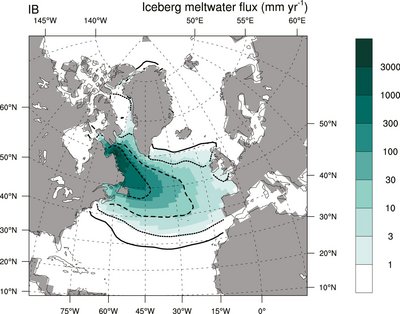Including icebergs in computer models helps to better understand past climate change
Long ago in Earth’s history, large numbers of icebergs broke off from ice shelves and ice sheets and drifted away into the oceans, where they melted. These events known as Heinrich events had a major impact on our planet’s climate. In the modern world icebergs are mainly known as fanciful creations of nature that sometimes reach the coast in the high latitudes. However, it is rarely mentioned that icebergs played an important role in changing Earth’s climate during the last glacial cycle that lasted nearly 120,000 years.
Icebergs originate from ice sheets and ice shelves. The high number of icebergs in the past is explained by the fact that there have been periods in Earth’s history when ice sheets were much more common terrain than nowadays. A good example is the Laurentide Ice Sheet which, at its maximum, covered all of Canada and the northern part of the USA during a significant part of the last glacial cycle.
As the massive ice sheets melted, armadas of icebergs broke off into the ocean and drifted away along with the ocean currents. As they moved, the icebergs melted, releasing meltwater into the ocean, making the surrounding water colder and fresher therefore changing its density which in turn affected the circulation. For example, the meltwater from icebergs among other effects, caused the slow-down of the Gulf Stream — the ocean current that carries warm water from the Gulf of Mexico across the Atlantic — resulting in a much colder climate in northern Europe.
Existing iceberg modules are implemented in a different way making it much more computationally expensive to simulate 120,000 years in a fully coupled experiment. The new iceberg module by Erokhina and Mikolajewicz allows for easy integration into the framework of ocean models as it uses the same model infrastructure. In their approach, the key parameter now is not the number of icebergs but how many icebergs of certain sizes are present in the ocean.
Original publication
Erokhina, O., & Mikolajewicz, U. (2024). A new Eulerian iceberg module for climate studies. Journal of Advances in Modeling Earth Systems, 16, e2023MS003807. https://doi.org/10.1029/2023MS003807
Contact
Dr. Olga Erokhina
Now at JASMINE - Japan Astrometry Satellite Mission for Infrared Exploration
olga.erokhina@uni-heidelberg.de
Uwe Mikolajewicz
Max Planck Institute for Meteorology
uwe.mikolajewicz@mpimet.mpg.de

